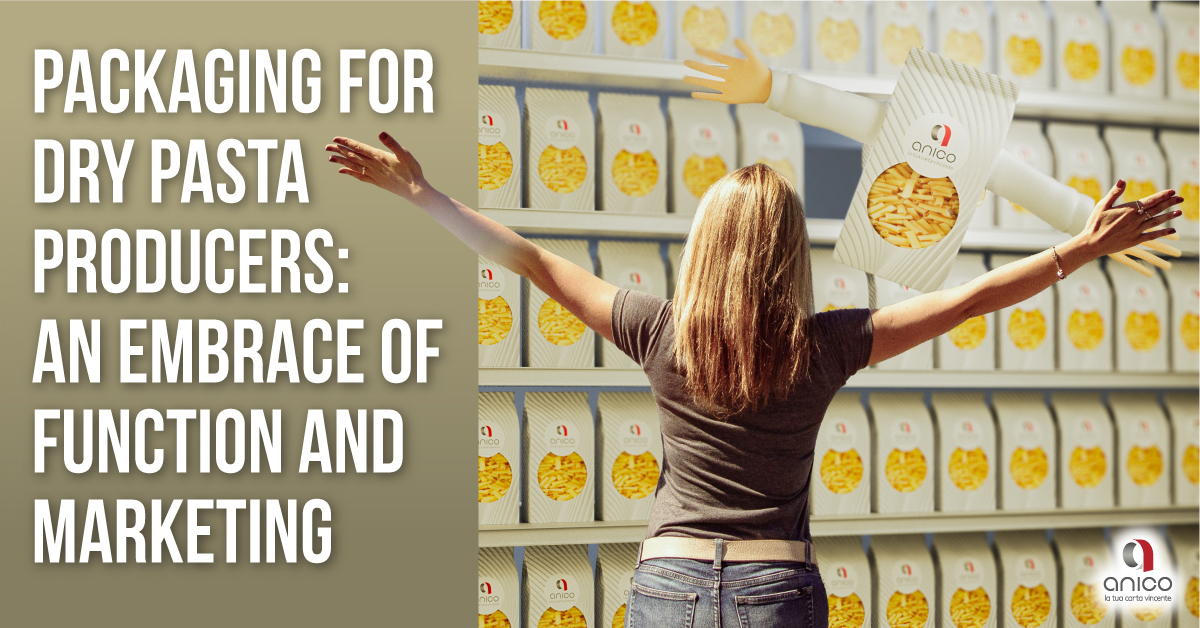In the world of dry pasta, packaging and content go hand in hand. Centuries have passed since dry pasta, in particular vermicelli, the oldest type of pasta, was simply wrapped in a sheet of paper and not always with the name of the manufacturer.
Over time, packaging for pasta producers has always had the function of preserving and protecting dry pasta during transport and storage, but it also served as a business card for the brand.
Today, well-designed and customized packaging becomes the key to standing out from the competition and attracts the attention of shoppers on crowded supermarket shelves, but it also tells the story of your brand and convinces consumers to choose your pasta over the competition, communicating your values.
In this article, we will explore the world of packaging for pasta manufacturers by analyzing:
• Available materials
• Different types of packaging
• Design elements to consider
• Emerging trends in the field of sustainability.
Materials: How can pasta packaging manufacturers find the perfect balance?
The choice of material for your dry pasta packaging is crucial. You need to find the right balance between protection, functionality, sustainability, and cost.
Let's take a look at the different materials used today:
• Cardboard is sturdy, customizable, recyclable and communicates an eco-friendly image. It can be used for classic boxes or with a transparent plastic window to show the dough.
• Plain paper or laminated paper is customisable and sustainable. These materials can be used for classic packaging or with a transparent window to show the inside.
• Plastic film is ideal for creating transparent packaging that highlights the product, but creates problems in terms of sustainability.
What are the main types of packaging for your dry pasta: from classics to innovations
The type of packaging you choose depends mainly on the type of pasta you produce:
• Cardboard boxes: suitable for short and long dry pasta. They can be with a transparent window or equipped with an easy opening system.
• Paper bags or laminated paper: used to pack dry pasta in smaller formats, with a transparent window to show the pasta which is contained or not. These bags allow a greater craftsmanship of the product, a good resistance and are also recyclable in paper since they have a low percentage of film.
• Plastic bags: used for various types of pasta, spaghetti in particular, but given European regulations, more sustainable alternatives are being sought.
Pasta packaging design tells your story
Your packaging design is an opportunity to tell your brand's story and your values, differentiating yourself from the competition.
Here are some elements that a pasta manufacturer must consider when choosing the packaging for their product:
• Logo and branding: they must be placed in a clearly visible way to strengthen the recognition of your brand.
• Colors and artworks: choose colors that reflect your brand identity and attract attention.
• Fonts and text: use legible fonts and clear text, which communicate key information about the product, such as the type of pasta, ingredients and nutritional information, and for the correct disposal of packaging.
• Images: use images that highlight your pasta and can whet consumers' appetites.
• Transparent windows: allow consumers to see the pasta, without having to open the package.
Dry pasta packaging trends towards sustainability
Sustainability has become a key factor in the food industry. Consumers are increasingly keen on environmental impact of the products they buy. Here are some pasta packaging trends that take sustainability into account:
• sustainable materials: use of 100% paper packaging
• Recycled materials: using recycled cardboard or plastic to reduce the environmental footprint of packaging.
• Minimalist packaging: minimizing the amount of material used for packaging, without compromising product protection.
Beyond the material: functionality and convenience for the consumer
In addition to aesthetics and sustainability, dry pasta packaging must also be functional and convenient for the consumer. The manufacturer needs to consider these aspects:
• Ease of opening: opening the package should be simple and intuitive, without requiring tools or too much strength.
• Closure system: if the package is resealable, the closure system must be secure and durable.
• Dosage: for some pasta shapes, such as single-dose short pasta, it is important to facilitate the dosage of the product.
• Nutritional information: Nutritional information should be easily readable and understandable.
• Recyclability: Packaging must be easily recyclable and instructions for disposal or recycling must be clear.
Packaging for dry pasta producers can contribute to its success
Pasta packaging is not just a wrapper to protect the product. It is a strategic element that can influence consumers' purchasing decisions, strengthen the brand and contribute to the success of your business.
By choosing the right materials such as the paper or laminated paper of our square bottom bags, the attractive design and features that meet the needs of consumers, you can create pasta packaging that is beautiful, sustainable and makes a difference!
Now it's up to you to choose which packaging you want for your dry pasta, and if you want support don't hesitate to contact us, we will be able to develop the best solution for your success.

